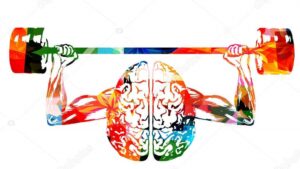Category Archives: Marketing History
The Myth of Willpower.
OK – let’s get this out of the way; despite my deliberately provocative title, willpower isn’t a myth. But there’s a lot of BS out there about willpower.
It’s that time of year – when those earnest new year’s resolutions made in January now lie in shambles. And that’s when willpower raises its ugly head. If you’ve failed to keep your resolutions, it’s likely you’re berating yourself for lacking willpower. Don’t. Behavior change is hard. Much of the self-flagellation in which people engage regarding willpower comes from a series of misunderstandings about what willpower is and how it works.
Let’s start with a definition. I think of willpower as the ability to delay gratification to serve long term goals. Examples: forgoing that donut so you’ll live longer, or bearing down and preparing your taxes in January so you’ll get your refund sooner.
Willpower is a good thing – it helps you get unpleasant-but-necessary stuff done. But there are key things to know about willpower, and a couple of misperceptions about it that need to be set straight. When conducting qualitative research on such topics as weight loss and smoking cessation, I see misunderstandings about willpower come up regularly.
Here are some things you need to know:
It’s a finite resource. I can’t stress this enough: willpower will only take you so far, as it eventually runs out. Psychologists and addiction counselors refer to ‘willpower fatigue.’ It’s also called ‘ego depletion,’ and it’s a real thing, having been documented in numerous studies. This is why the failure rate for most weight loss programs is so high: they depend on an indefinite, limitless supply of willpower to achieve lasting success.
Not only is willpower finite over time, it is also finite in the moment; if you’re exercising willpower in one aspect of life, there will be less for other things. If you’re gritting your teeth to get your taxes done, you might find it doubly difficult to resist that donut. This is one reason people trying to quit smoking often gain weight – they’re expending so much mental energy resisting nicotine cravings, they’re less able to police their eating. Willpower can also be compromised by stress and fatigue – think about how hard it is to eat right when traveling on business.
Willpower is a skill. It’s something that can be learned. Like a muscle, it can be strengthened through training and repetition, and it can atrophy from disuse. Psychologist have shown that by consistently exercising willpower in small ways, people can become more adept at resisting bigger temptations.
Your eNewsletter Continues Here …
And here are two major misperceptions about willpower:
Willpower is a matter of character. Successful people often attribute their achievements to willpower, self-discipline, and perseverance, and believe that those who are less successful lack these qualities. Similarly, we tend to assume that others who are successful must be highly disciplined individuals. As a qualitative researcher, I hear this sort of thinking all the time, and believe it is simplistic and wrong. If you think success comes from willpower and that willpower is a virtue, then those who have experienced failure in their lives must lack this virtue and be, by definition, weak and immoral individuals. This sort of thinking is unfairly judgmental.
Willpower is all you need. The idea that willpower alone can drive behavior changes – particularly permanent ones – is something I hear frequently. However, without motivation and environmental change, willpower by itself is insufficient. I’ve conducted many focus groups and interviews on the topic of weight loss. I’ve noticed that not all people trying to shed weight really want to – they’re doing it because a healthcare provider or family member is pushing them to do it. So, they’re not motivated to make necessary behavioral changes.
I’ve also seen that people who successfully lost weight were able to because they changed their environment – they removed fattening foods from their homes and workplaces, stopped going where fattening foods would be present, and were able to reduce the cravings that cause them to overconsume fattening foods. Without these environmental changes, they wouldn’t have been able to instill the permanent behavior changes that facilitated the weight loss.
I’ll wrap up with a few tips:
Do what you can to make willpower unnecessary (or, at least, less so). Behavior changes often are tripped up by cravings and temptations. I’ve done a number of qualitative research studies that involved speaking to addiction counselors. One thing they repeatedly emphasized is that cravings can eventually subside through abstinence. While this takes time, during which willpower is essential, eventually the reduction or elimination of the craving makes willpower less necessary.
Focus on your environment. If willpower is about resisting temptation, removing sources of temptation from your environment will make willpower less necessary.
Focus on motivation. If you’re attempting to make a behavior change, have an honest conversation with yourself about what’s motivating this change. Is it in your economic interest to make this change? Is there some psychological or self-esteem benefit to be gained? Make sure you really understand, in as much detail as possible, what, if anything, is driving this change.
Rather than trying to eliminate a behavior, start by replacing it. This is why nicotine gum is helpful to those trying to quit smoking – it replaces the act of putting a cigarette in their mouths with a piece of gum. This still requires some willpower, but less than doing nothing would require.
We all know it: behavior change is challenging. But, if you want it make it a little easier, do what you can to reduce the importance of willpower.
Virtue Signaling: What It Is And Why It Matters.
 At a few social functions over the holidays, as well as in the media, I noticed the term ‘virtue signaling’ being used in a negative way. The notion that virtue signaling is somehow a bad thing seems to be increasingly common.
At a few social functions over the holidays, as well as in the media, I noticed the term ‘virtue signaling’ being used in a negative way. The notion that virtue signaling is somehow a bad thing seems to be increasingly common.
Let’s take a minute to define the term: virtue signaling is how you demonstrate you are a good person through opinions you express or personal behaviors you model. When somebody accuses you of it, the implication is that you’re ‘putting on a show’ or are ‘full of BS.’ Some examples of virtue signaling might include talking about your fat-free diet, wearing an “I support public radio” t-shirt, or bragging about your 80-hour work week.
People tend to find virtue signaling annoying, which creates friction in conversations and relationships. While it’s easy to disregard virtue signaling since it can be so off-putting, I recommend paying close attention to it for these reasons:
Everybody does it. If you think you don’t, think again. Homo Sapiens is the moral animal. Our sense of right and wrong is always front and center in our thoughts— it’s what sets us apart from other species. So, signaling morality to our fellow humans is as natural as breathing. We all do it, and we do it all the time. This presents a paradox: we do it ourselves, but we find it obnoxious in others. If you had run into me on election day back in November, you would have seen me wearing an ‘I voted’ sticker and an ‘I gave blood today’ sticker, and feeling very smug. You probably would have crossed the street to avoid talking to me.
It can tell you a lot about people and their values. Virtue signaling is a form of ‘morality by proxy.’ A proxy is something that represents the value of something else, so virtue signaling is a behavior that represents a moral value. Because we’re so attuned to morality as a species, we use personal attributes as proxies for moral character in others: physical beauty and wealth to name two. And, when we want others to notice our virtues, we signal them. You might do this by displaying your muscles at the gym or by making a show of your electric car.
So, when people virtue signal, they are telling you something about themselves that they believe is important – giving you a window into their self-image. This presents a great opportunity to learn more about them.
Your eNewsletter continues here …
I’ve certainly noticed when conducting qualitative research that participants sometimes try to put each other on the defensive or quash disagreement either by virtue signaling or by questioning the sincerity of others who are doing it. Here’s an example:
While moderating focus groups on educational software, talking to parents who homeschool, one mother of a 7-year-old said: “Obviously, I would never have my daughter use that. Everything she learns she gets from me.” Several other participants vigorously agreed. A dad who had a 14-year-old pushed back: “my daughter is doing stuff right now – particularly in math – that’s over my head. The software I bought is teaching her material I can’t.” The mom replied, “I just could never do that,” the dad accused her of “self-righteous BS,” and it went downhill from there.
A little later, after things had calmed down, I asked the anti-software mom, “what do you think that says about you as a parent?” She replied, “that I’m not willing to take shortcuts or make anything less than a full effort.” Another like-minded parent chimed in, “I think it says I’m an old-school homeschooler.” And, when I asked what ‘old-school’ meant to him, he said it meant he lives by “traditional values.” This led to a good conversation about ‘traditional values’ – what they are and what they have to do with homeschooling.
Pay attention to virtue signaling, but be careful about taking it at face value. While it can tell you a lot about how people see themselves, remember that they might be blowing smoke. The fact that you gave $50 to public radio last year – and are displaying the tote bag to prove it – doesn’t by itself make you generous. The fact that you drive a Prius doesn’t make you a committed environmentalist.
Virtue signaling is neither a good thing nor a bad thing, it’s just a human thing. We can no more stop doing it than we can stop breathing. However, we can train ourselves to become more aware of it in ourselves and others. Try paying attention to the virtues you signal and how you go about that. Think about what kind of impression are you creating and, how it affects relationships and interactions with your fellow humans. As for other people’s virtue signaling, treat it as an opportunity to ask questions and get to know them better.
When To Trust Your Intuition.
 A while ago, I was conducting focus groups on new frozen food products. Of 12 concepts, participants consistently called two interesting, but said they probably wouldn’t try them, as their freezers were overfull.
A while ago, I was conducting focus groups on new frozen food products. Of 12 concepts, participants consistently called two interesting, but said they probably wouldn’t try them, as their freezers were overfull.
My instinct was to be skeptical of the ‘no-room-in-the-freezer’ justification. Between groups I thought about why, and recalled that the ‘no room’ rationale was often code for ‘this product offers no benefit’ – something I learned early in my career from friend and researcher-extraordinaire, Phil Glowatz.
Meanwhile, the clients in attendance were encouraged by the feedback on those ideas, and planned to put resources toward further development. I continued to probe reactions to these concepts, pushing participants to explain the basis for their professed interest.
Ultimately, we learned this: for the younger, apartment-dwelling participants, my intuition was wrong. They were genuinely interested, but were strapped for space in their tiny apartment freezers. However, I was right about the older suburbanites, who couldn’t articulate a coherent case for their interest. Eventually, some admitted that they were just trying to be nice. As a result, the client turned development efforts toward a smaller package and a formulation that didn’t need to be frozen.
The point of all this: intuition is valuable, but you must be careful about trusting it. Knowing when and how much to rely on intuition is an important skill, no matter what you do.
There are two kinds of intuition:
-
Rapid, subconscious analysis of information informed by prior experience.
-
Impulsive judgements shaped by your desires and biases. So sometimes intuition is your brain working incredibly fast, and sometimes it’s your brain just being lazy.



